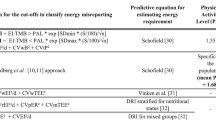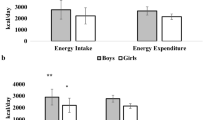Abstract
Background/Objectives:
To analyze the anthropometric, metabolic, psychosocial and dietary profiles of underreporters, identified by the doubly labeled water technique, in a well-characterized population of overweight and obese postmenopausal women.
Subjects/Methods:
The study population consisted of 87 overweight and obese sedentary postmenopausal women (age: 57.7±4.8 years, body mass index: 32.4±4.6 kg/m2). Subjects were identified as underreporters based on the energy intake to energy expenditure ratio of <0.80. We measured (1) body composition (by dual-energy X-ray absorptiometry), (2) visceral fat (by computed tomography), (3) blood profile, (4) resting blood pressure, (5) peak oxygen consumption (VO2 peak), (6) total energy expenditure, (7) muscle strength and (8) psychosocial and dietary profiles.
Results:
Out of 87 subjects, 50 (57.5%) were identified as underreporting subjects in our cohort. Underreporters showed higher levels of body mass index, fat mass, visceral fat, hsC-reactive protein, perceived stress and percentage of energy from protein, as well as lower levels of VO2 peak, dietary intake of calcium, fiber, iron, vitamin B-1 and 6, as well as servings of fruit and vegetables. Logistic regression analysis showed that fat mass, odd ratio 1.068 (95% confidence interval 1.009–1.130) and perceived stress, odd ratio 1.084 (95% confidence interval 1.011–1.162) were independent characteristics of underreporters.
Conclusions:
Results from this study show significant differences in anthropometric, metabolic, psychosocial and dietary profiles between underreporters and non-underreporters in our cohort of overweight and obese postmenopausal women.
This is a preview of subscription content, access via your institution
Access options
Subscribe to this journal
Receive 12 print issues and online access
$259.00 per year
only $21.58 per issue
Buy this article
- Purchase on Springer Link
- Instant access to full article PDF
Prices may be subject to local taxes which are calculated during checkout
Similar content being viewed by others
References
Abbot JM, Thomson CA, Ranger-Moore J, Teixeira PJ, Lohman TG, Taren DL et al. (2008). Psychosocial and behavioral profile and predictors of self-reported energy underreporting in obese middle-aged women. J Am Diet Assoc 108, 114–119.
Asbeck I, Mast M, Bierwag A, Westenhofer J, Acheson KJ, Muller MJ (2002). Severe underreporting of energy intake in normal weight subjects: use of an appropriate standard and relation to restrained eating. Public Health Nutr 5, 683–690.
Baranowski T, Perry C, Parcel G (2003). How individuals, environments, and health behavior interact. In: Glanz K, Rimer BK, Lewis FM (eds). Health Behavior and Health Education. Theory, Research, and Practice. Jossey-Bass Inc.: San Francisco, pp 165–184.
Bazelmans C, Matthys C, De Henauw S, Dramaix M, Kornitzer M, De Backer G et al. (2007). Predictors of misreporting in an elderly population: the ‘Quality of life after 65’ study. Public Health Nutr 10, 185–191.
Black AE, Cole TJ (2000). Within- and between-subject variation in energy expenditure measured by the doubly-labelled water technique: implications for validating reported dietary energy intake. Eur J Clin Nutr 54, 386–394.
Black AE, Cole TJ (2001). Biased over- or under-reporting is characteristic of individuals whether over time or by different assessment methods. J Am Diet Assoc 101, 70–80.
Briefel RR, Sempos CT, McDowell MA, Chien S, Alaimo K (1997). Dietary methods research in the third National Health and Nutrition Examination Survey: underreporting of energy intake. Am J Clin Nutr 65, 1203S–1209S.
Cohen S, Kamarck T, Mermelstein R (1983). A global measure of perceived stress. J Health Soc Behav 24, 385–396.
Dwyer J, Picciano MF, Raiten DJ (2003). Estimation of usual intakes: what we eat in America-NHANES. J Nutr 133, 609S–623S.
Ghiselli EE, Campbell JP, Zedeck S (1981). Measurement Theory for the Behavioral Sciences. WH Freeman: San Francisco. p 494.
Hill RJ, Davies PS (2001). The validity of self-reported energy intake as determined using the doubly labelled water technique. Br J Nutr 85, 415–430.
Hirvonen T, Mannisto S, Roos E, Pietinen P (1997). Increasing prevalence of underreporting does not necessarily distort dietary surveys. Eur J Clin Nutr 51, 297–301.
Huang TT, Roberts SB, Howarth NC, McCrory MA (2005). Effect of screening out implausible energy intake reports on relationships between diet and BMI. Obes Res 13, 1205–1217.
Iqbal R, Anand S, Ounpuu S, Islam S, Zhang X, Rangarajan S et al. (2008). Dietary patterns and the risk of acute myocardial infarction in 52 countries: results of the INTERHEART study. Circulation 118, 1929–1937.
Janz NK, Champion VL, Strecher VJ (2003). The Health Belief Model. In: Glanz K, Rimer BK, Lewis FM (eds). Health Behavior and Health Education. Theory, Research, and Practice, 3rd edn. Jossey-Bass Inc.: San Francisco, pp 45–66.
Lanctot JQ, Klesges RC, Stockton MB, Klesges LM (2008). Prevalence and characteristics of energy underreporting in African-American girls. Obesity (Silver Spring) 16, 1407–1412.
Livingstone MB, Black AE (2003). Markers of the validity of reported energy intake. J Nutr 133 (Suppl 3), 895S–920S.
Livingstone MB, Robson PJ, Black AE, Coward WA, Wallace JM, McKinley MC et al. (2003). An evaluation of the sensitivity and specificity of energy expenditure measured by heart rate and the Goldberg cut-off for energy intake: basal metabolic rate for identifying mis-reporting of energy intake by adults and children: a retrospective analysis. Eur J Clin Nutr 57, 455–463.
McDowell I, Newell C (1996). Measuring Health: A Guide to Rating Scales and Questionnaires, 2nd edn. Oxford University Press: New York. p 523.
McQueen MJ, Hawken S, Wang X, Ounpuu S, Sniderman A, Probstfield J et al. (2008). Lipids, lipoproteins, and apolipoproteins as risk markers of myocardial infarction in 52 countries (the INTERHEART study): a case-control study. Lancet 372, 224–233.
Mendelson BK, Mendelson MJ, White DR (2001). Body-esteem scale for adolescents and adults. J Pers Assess 76, 90–106.
Messier V, Malita FM, Rabasa-Lhoret R, Brochu M, Karelis AD (2008). Association of cardiorespiratory fitness with insulin sensitivity in overweight and obese postmenopausal women: a Montreal Ottawa New Emerging Team study. Metabolism 57, 1293–1298.
Novotny JA, Rumpler WV, Riddick H, Hebert JR, Rhodes D, Judd JT et al. (2003). Personality characteristics as predictors of underreporting of energy intake on 24-h dietary recall interviews. J Am Diet Assoc 103, 1146–1151.
Price GM, Paul AA, Cole TJ, Wadsworth ME (1997). Characteristics of the low-energy reporters in a longitudinal national dietary survey. Br J Nutr 77, 833–851.
Pryer JA, Vrijheid M, Nichols R, Kiggins M, Elliott P (1997). Who are the ‘low energy reporters’ in the dietary and nutritional survey of British adults? Int J Epidemiol 26, 146–154.
Rosell MS, Hellenius ML, de Faire UH, Johansson GK (2003). Associations between diet and the metabolic syndrome vary with the validity of dietary intake data. Am J Clin Nutr 78, 84–90.
Rosenberg M (1965). Society and the Adolescent Self-Image. Princeton University Press: Princeton. p 326.
Rosengren A, Hawken S, Ounpuu S, Sliwa K, Zubaid M, Almahmeed WA et al. (2004). Association of psychosocial risk factors with risk of acute myocardial infarction in 11 119 cases and 13 648 controls from 52 countries (the INTERHEART study): case-control study. Lancet 364, 953–962.
Samuel-Hodge CD, Fernandez LM, Henriquez-Roldan CF, Johnston LF, Keyserling TC (2004). A comparison of self-reported energy intake with total energy expenditure estimated by accelerometer and basal metabolic rate in African-American women with type 2 diabetes. Diabetes Care 27, 663–669.
St-Pierre DH, Cianflone K, Smith J, Coderre L, Karelis AD, Imbeaut P et al. (2009). Change in plasma acylation stimulating protein during euglycemic-hyperinsulinemic clamp in overweight and obese postmenopausal women: a MONET study. Clin Endocrinol (Oxf) 70, 539–546.
Stewart AL, Greenfield S, Hays RD, Wells K, Rogers WH, Berry SD et al. (1989). Functional status and well-being of patients with chronic conditions. Results from the Medical Outcomes Study. JAMA 262, 907–913.
Strychar I, Lavoie M, Messier L, Karelis A, Fontaine J, Doucet E et al. (2009). Metabolic, psychosocial, and dietary characteristics of overweight/obese postmenopausal women with a history of weight cycling: A MONET Study. J Am Diet Assoc 109, 512–516.
Stunkard AJ, Messick S (1985). The three-factor eating questionnaire to measure dietary restraint, disinhibition and hunger. J Psychosom Res 29, 71–83.
Tooze JA, Subar AF, Thompson FE, Troiano R, Schatzkin A, Kipnis V (2004). Psychosocial predictors of energy underreporting in a large doubly labeled water study. Am J Clin Nutr 79, 795–804.
Trabulsi J, Schoeller DA (2001). Evaluation of dietary assessment instruments against doubly labeled water, a biomarker of habitual energy intake. Am J Physiol Endocrinol Metab 281, E891–E899.
Voss S, Kroke A, Klipstein-Grobusch K, Boeing H (1998). Is macronutrient composition of dietary intake data affected by underreporting? Results from the EPIC-Potsdam Study. European prospective investigation into cancer and nutrition. Eur J Clin Nutr 52, 119–126.
Acknowledgements
This study was supported by grants from the Canadian Institutes of Health Research (University of Montreal and University of Ottawa New Emerging Team project). Dr Rémi Rabasa-Lhoret, Dr Antony Karelis, Marie-Eve Lavoie and Virginie Messier are supported by the Fonds de la Recherche en Santé du Québec. Dr Rémi Rabasa-Lhoret is the recipient of the J-A DeSeve Research Chair for Clinical Research. Éric Doucet is a recipient of a CIHR/Merck-Frosst New Investigator Award, a Canadian Foundation for Innovation New Opportunities Award and an Early Research Award (Ontario).
Author information
Authors and Affiliations
Corresponding author
Rights and permissions
About this article
Cite this article
Karelis, A., Lavoie, ME., Fontaine, J. et al. Anthropometric, metabolic, dietary and psychosocial profiles of underreporters of energy intake: a doubly labeled water study among overweight/obese postmenopausal women—a Montreal Ottawa New Emerging Team study. Eur J Clin Nutr 64, 68–74 (2010). https://doi.org/10.1038/ejcn.2009.119
Received:
Revised:
Accepted:
Published:
Issue Date:
DOI: https://doi.org/10.1038/ejcn.2009.119
Keywords
This article is cited by
-
Misreport of energy intake assessed with food records and 24-h recalls compared with total energy expenditure estimated with DLW
European Journal of Clinical Nutrition (2016)
-
Increased vitamin D-binding protein and decreased free 25(OH)D in obese women of reproductive age
European Journal of Nutrition (2014)
-
Underreporting in obese inpatients undergoing a psycho-nutritional rehabilitative program
Eating and Weight Disorders - Studies on Anorexia, Bulimia and Obesity (2013)



